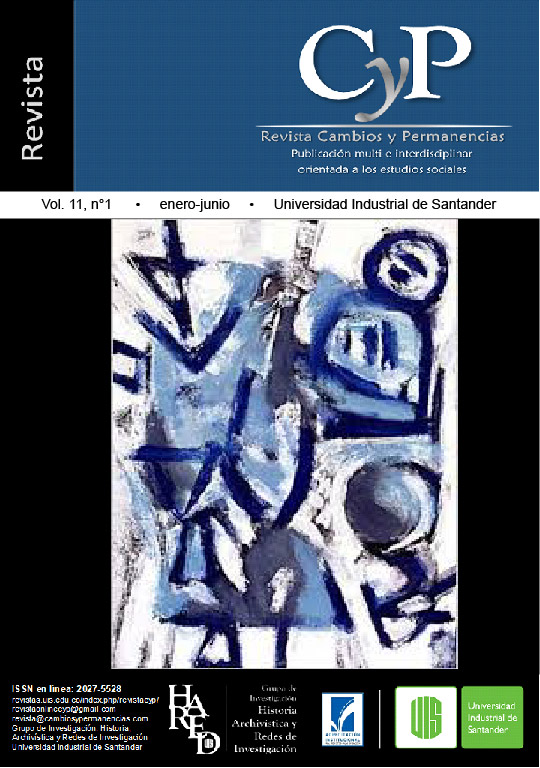The wise men gathered to tell stories. Folk art and diverse voices through oral history
Published 2020-06-30
Keywords
- Oral history,
- popular art,
- tradition,
- culture,
- identity
How to Cite
Abstract
This paper is the result of a completed investigation, it deals with the use of oral history to investigate and make visible the work of Gumercindo España Olivares, better known as "Sshinda", extraordinary toymaker and oral narrator from Guanajuato, Mexico.
Understanding the importance of the past through oral history seems an arduous task, it is common for many historians to recover the memory of characters who have been classified as “anonymous”, it is not interesting, however, we know that in recent decades oral history has played a very valuable role in making the work of these types of characters visible.
With the intention of exposing the link between popular art and diverse voices through oral history, in this communication I note the qualitative methodological proposal to investigate and make visible the work of the Sshinda, through in-depth interviews, ethnographic description and recovery of oral testimonies to account for the processes, techniques, designs, mechanisms and the diversity of toys that this character managed to build in order to establish himself as one of the most important toymakers in Mexico and which achieved international recognition.
Downloads
References
Aceves Lozano, J. E. (coord.). (2000). Historia Oral: ensayos y aportes de investigación. Seminario de Historia Oral y Enfoque Biográfico. México: CIESAS.
España Olivares, G. (23 de junio de 2005) Comunicación personal, Santa Cruz de Juventino Rosas, Gto.
España Olivares, G. (30 de marzo 2008) Comunicación personal, Santa Cruz de Juventino Rosas, Gto.
España Olivares, G. (9 de noviembre 2006) Comunicación personal, Santa Cruz de Juventino Rosas, Gto.
España Olivares, G. (S. F.). Comunicación personal junto con R. Briseño León, Santa Cruz de Juventino Rosas, Gto.
Espejel, C. (1977). Artesanía popular mexicana. México: Editorial Blume.
Hernández, F. J. (1969). ¿Hubo juguetes en la época prehispánica? Artes de México. El juguete mexicano, Año XVI, (125), 5.
Hernández, F. J. (1993). Entre el Azar y el Vértigo. Juegos y Juguetes en el México del siglo XIX. Juegos y juguetes mexicanos. p. 102.
Iturbe, M. (1996). Arte popular. Estética y poesía. En C. Mosiváis., F. del Paso., J. E. Pacheco, Belleza y poesía en el arte popular mexicano (p. 10). México: Circuito Artístico Regional.
Iturriaga, J. N. (2005). El arte popular en los estados de la República. En Arte del Pueblo. Manos de Dios. Colección del Museo de Arte Popular (p. 580). México: Gobierno del Distrito Federal-CONACULTA-INBA-Museo de Arte Popular.
Mallimaci, F., y Giménez Béliveau, V. (2006). Historias de vida y los métodos biográficos. En I. Vasilachis de Gialdino (coord.), Estrategias de investigación cualitativa (pp. 175-176). Barcelona, España: Editorial Gedisa.
Martínez Massa, P. (S. F.). Artesanía en IberoAmerica. Un solo mundo. España: Sociedad Estatal Quinto Centenario - Ministerio de Industria, Comercio y Turismo – Agencia Española de Cooperación Internacional – Lunwerg Editores.
Martínez Peñaloza, P. (1981). Arte popular de México. La creatividad artística del pueblo mexicano a través de los tiempos. México: Panorama Editorial.
Matos Moctezuma, E. (1993). Juegos y juguetes en el México antiguo. Juegos y juguetes mexicanos. 24.
Medrano de Luna, G. y Pedrosa, J. M. (2018). Te voy a platicar la del toro o la del borrego. ¿Cuál de las dos?: nueve tramas de El hombre que hicieron güey (o Pitas Pajas) según Sshinda, narrador mexicano. eHumanista, 39. 366-399.
Medrano de Luna, G., y Pedrosa, J. M. (2018). El Mágico que hizo pacto con el diablo, relato oral de Sshinda, narrador y juguetero otomí. Revista de Literaturas Populares, (18), 73-114.
Rubín de la Borbolla, D. F. (1961). Las Artes Populares Guanajuatenses. Guanajuato, México: Gobierno del Estado de Guanajuato. Recuperado de https://dle.rae.es/historia .
Vasilachis de Gialdino, I. (2006). Estrategias de investigación cualitativa. Barcelona, España: Editorial Gedisa.

